08_线性回归详解
线性回归详解
1、包导入与数据创建
import numpy as np
import matplotlib
import matplotlib.pyplot as plt
# 绘图全局参数设置
config = {
"font.family": 'Times New Roman',
"font.size": 14,
"font.serif": 'Simsun',
}
matplotlib.rcParams.update(config)
导入需要的数据处理包numpy和绘图包matplotlib
# 随机生成100个样本
X = 2 * np.random.rand(100, 1)
# 使用一次线性公式4+3*x并增加随机数来模拟噪音影响
y = 4 + 3 * X + np.random.randn(100, 1)
# 显示生成的数据
plt.plot(X, y, 'b.')
plt.xlabel('X')
plt.ylabel('y')
plt.axis([0, 2, 0, 15])
plt.show()
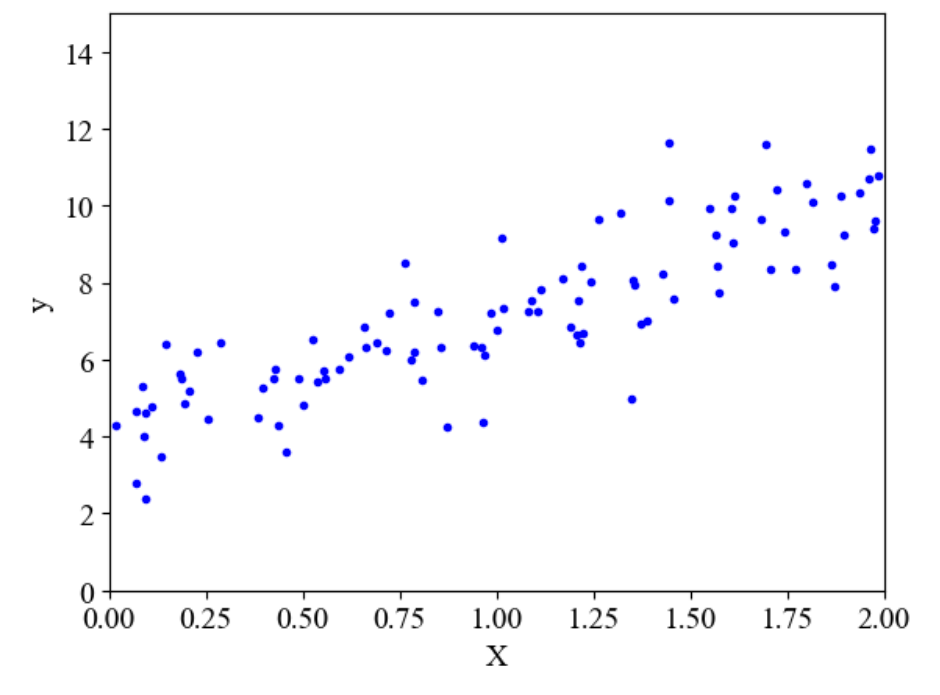
2、直接求解法
损失函数:
\(\displaystyle J(\theta) = \frac12\sum^m_{i=1}(y^i - \theta^Tx^i)^2=\frac12\sum^m_{i=1}(h_\theta(x^i)-y^i)^2 = \frac12(X\theta - y)^T(X\theta-y)\)
损失函数求导:
\(\displaystyle \nabla_\theta J(\theta)=\nabla_\theta [\frac12(X\theta - y)^T(X\theta-y)]=\nabla_\theta[\frac12(\theta^TX^T-y^T)(X\theta-y)]\)
\(\displaystyle =\nabla_\theta[\frac12(\theta^TX^TX\theta-\theta^TX^Ty-y^TX\theta+y^Ty)]\)
\(\displaystyle =\frac12(2X^TX\theta-X^Ty-(y^TX)^T)=X^TX\theta-X^Ty\)
让损失函数求导后等于0建立方程求得:
\(\displaystyle \theta = (X^TX)^{-1}X^Ty\)
直接求解
# 增加一列 1, 作为偏置项参数
X_b = np.c_[np.ones((100, 1)), X]
theta_best = np.linalg.inv(X_b.T.dot(X_b)).dot(X_b.T).dot(y)
print(theta_best)

# 预测
X_new = np.array([[0], [2]])
X_new_b = np.c_[np.ones((2, 1)), X_new]
y_predict = X_new_b.dot(theta_best)
print(y_predict)

# 绘制回归线
plt.plot(X_new, y_predict, 'r--')
plt.plot(X, y, 'b.')
plt.xlabel('X')
plt.ylabel('y')
plt.axis([0, 2, 0, 15])
plt.show()
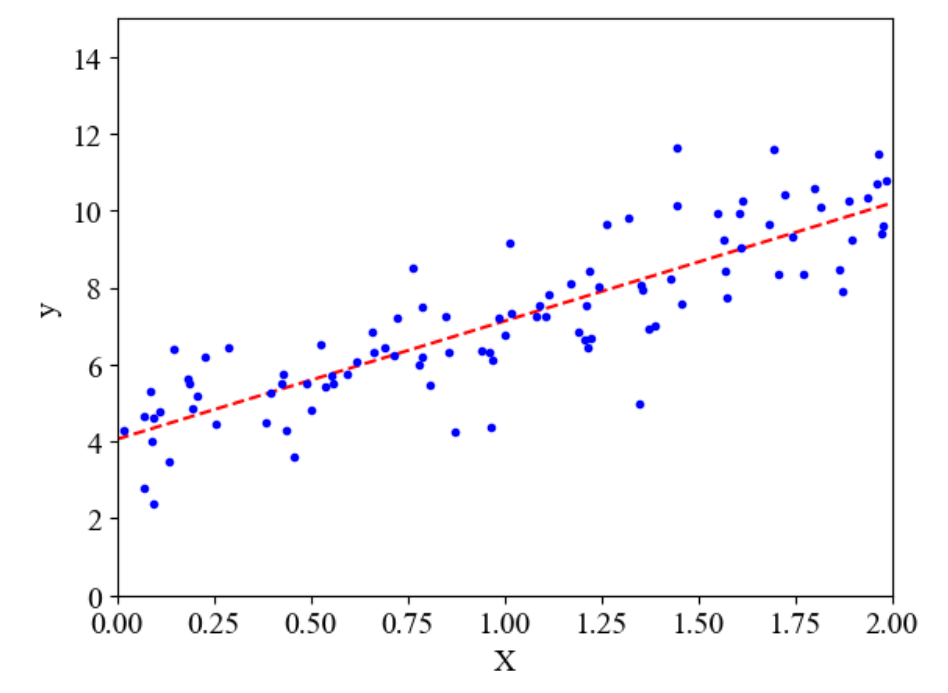
from sklearn.linear_model import LinearRegression
# 这里使用的是直接求导的方程方法
lin_reg = LinearRegression()
lin_reg.fit(X, y)
print(lin_reg.coef_)
print(lin_reg.intercept_)

- 优点:得到的结果是最优解
- 缺点:由于求解公式中有求逆的存在,而并不是所有的矩阵都能求逆,并且在数据量比较大时,计算速度比较慢,所以有了梯度下降的方法
3、梯度下降准备
-
正常梯度下降:先随机选取一个初始点,然后一步步逼近最优解
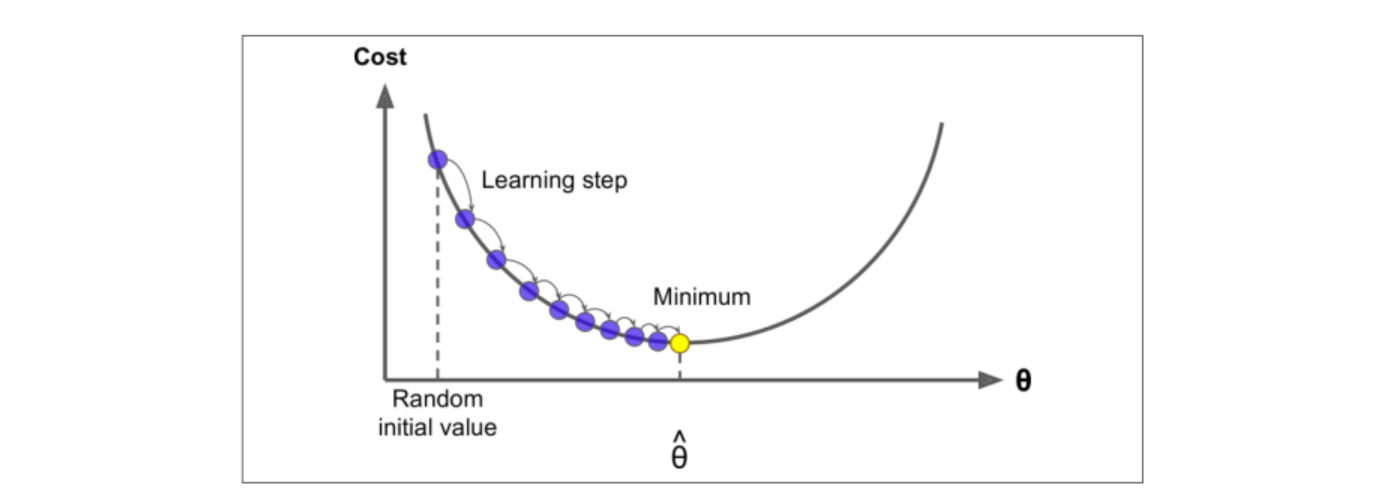
-
步长太小:会导致求解时间长

-
步长太大:求解过程跌宕起伏,得到的解不好,所以一般步长宁可小也不能大

-
局部最优解:在线性回归中一般都不会有局部最优解,因为线性回归是凸函数,但是在有些问题中会存在这样的问题

对于这种问题需要多做几组实验,在不同的位置选取初始点,在绝大部分机器学习问题中都不存在局部最优解
-
数据处理标准化:让所有特征数据的取值范围一致,从而方便求解,拿到数据之后基本上都需要进行标准化操作

标准化只是数据预处理中的一种,在sklearn中有一个专门的预处理模块 sklearn.preprocessing,里面有很多预处理的函数
4、批量梯度下降
公式:
\(\displaystyle J(\theta) = \frac1{2m}\sum^m_{i=1}(h_\theta(x^i)-y^i)^2\)
\(\displaystyle \frac{\partial J(\theta)}{\partial \theta_j} = \frac1m \sum^m_{i=1}(h_\theta(x^i)-y^i)x^i_j\)
\(\displaystyle \theta_j' = \theta_j - \alpha\frac1m \sum^m_{i=1}(h_\theta(x^i)-y^i)x^i_j\)
\(\displaystyle \theta' = \theta - \alpha \frac1m X^T(X\theta - y)\)
# 批量梯度下降
eta = 0.2
n_iterations = 1000
m = len(X_b)
theta = np.random.randn(2, 1)
for iteration in range(n_iterations):
gradients = 1/m*X_b.T.dot(X_b.dot(theta) - y)
theta = theta - eta * gradients
print(theta)

我们来尝试不同学习率对模型的影响
# 绘图
theta_path_bgd = []
def plot_gradient_descent(theta, eta, theta_path = None):
m = len(X_b)
plt.plot(X, y, 'b.')
n_iterations = 1000
for iteration in range(n_iterations):
y_predict = X_new_b.dot(theta)
gradients = 1/m*X_b.T.dot(X_b.dot(theta) - y)
theta = theta - eta * gradients
if theta_path:
theta_path.append(theta)
plt.plot(X_new, y_predict, 'r-')
plt.xlabel('X_1')
plt.axis([0, 2, 0, 15])
plt.title(f'eta = {eta}')
theta = np.random.randn(2, 1)
plt.figure(figsize=(10, 4))
plt.subplot(131)
plot_gradient_descent(theta, eta = 0.02)
plt.subplot(132)
plot_gradient_descent(theta, eta = 0.2)
plt.subplot(133)
plot_gradient_descent(theta, eta = 1)
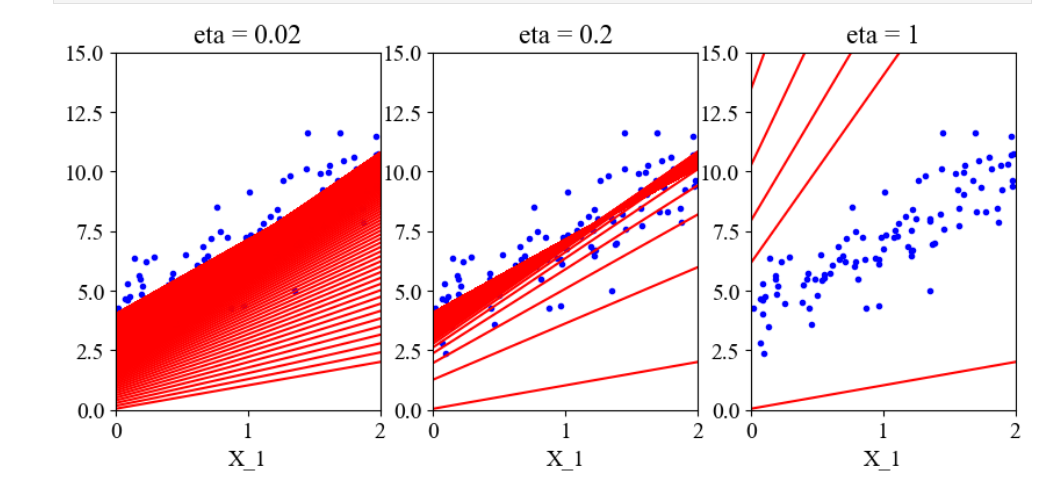
可以直观的看到,当学习率太小时,模型需要很多步才能达到最优解;而学习率太大时,模型确不能达到最优解。所以在实际运用中,学习率宁可小也不能大
5、随机梯度下降
公式:
\(\displaystyle \theta' = \theta - \alpha(h_\theta(x^i)-y^i)x^i_j = \theta - \alpha(x_j^i\theta-y^i)x^i_j\)
theta_path_sgd = []
m = len(X_b)
n_epochs = 10
t0 = 5
t1 = 50
theta = np.random.randn(2, 1)
def learning_schedule(t):
return t0 / (t1 + t)
for epoch in range(n_epochs):
for i in range(m):
if epoch < 4 and i % 2 == 0:
y_predict = X_new_b.dot(theta)
plt.plot(X_new, y_predict, 'r-')
random_index = np.random.randint(m)
xi = X_b[random_index:random_index+1]
yi = y[random_index:random_index+1]
gradients = xi.T.dot(xi.dot(theta) - yi)
eta = learning_schedule(epoch * m + 1)
theta = theta - eta*gradients
theta_path_sgd.append(theta)
plt.plot(X, y, 'b.')
plt.axis([0, 2, 0, 15])
plt.show()
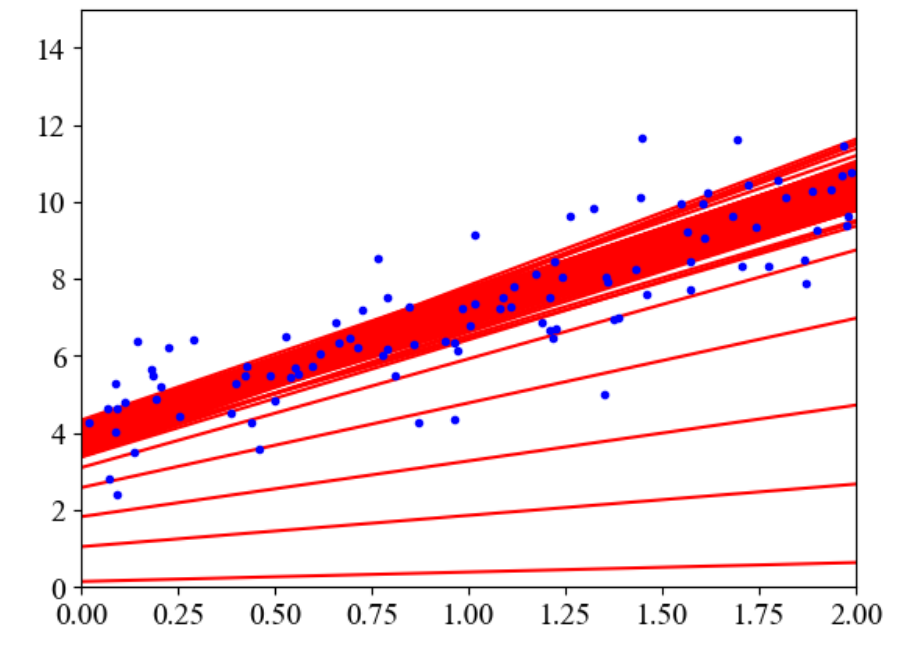
6、小批量随机梯度下降
公式:
\(\displaystyle \theta_j' = \theta_j - \alpha\frac1{batch} \sum^{i+batch-1}_{k=1}(h_\theta(x^k)-y^k)x^k_j\)
\(\displaystyle = \theta_j - \alpha \frac1{batch} X_j^T(X_j\theta - y_j)\)
theta_path_mgd = []
n_epochs = 10
minibatch = 16
theta = np.random.randn(2, 1)
for t, epoch in enumerate(range(n_epochs)):
shuffled_indices = np.random.permutation(m)
X_b_shuffled = X_b[shuffled_indices]
y_shuffled = y[shuffled_indices]
for i in range(0, m, minibatch):
xi = X_b_shuffled[i:i+minibatch]
yi = y_shuffled[i:i+minibatch]
gradients = 1 / minibatch * xi.T.dot(xi.dot(theta) - yi)
eta = learning_schedule(t)
theta = theta - eta * gradients
theta_path_mgd.append(theta)
print(theta)

7、三种梯度下降对比
theta_path_bgd = np.array(theta_path_bgd)
theta_path_sgd = np.array(theta_path_sgd)
theta_path_mgd = np.array(theta_path_mgd)
plt.figure(figsize=(8, 4))
plt.plot(theta_path_sgd[:, 0], theta_path_sgd[:, 1], 'g-+', markersize=3, linewidth=1, label='SGD')
plt.plot(theta_path_mgd[:, 0], theta_path_mgd[:, 1], 'b-o', markersize=3, linewidth=1, label='MGD')
plt.plot(theta_path_bgd[:, 0], theta_path_bgd[:, 1], 'r-s', markersize=3, linewidth=1, label='BGD')
plt.legend(loc='upper right')
plt.axis([3, 4.2, 2.5, 4.5])
plt.show()
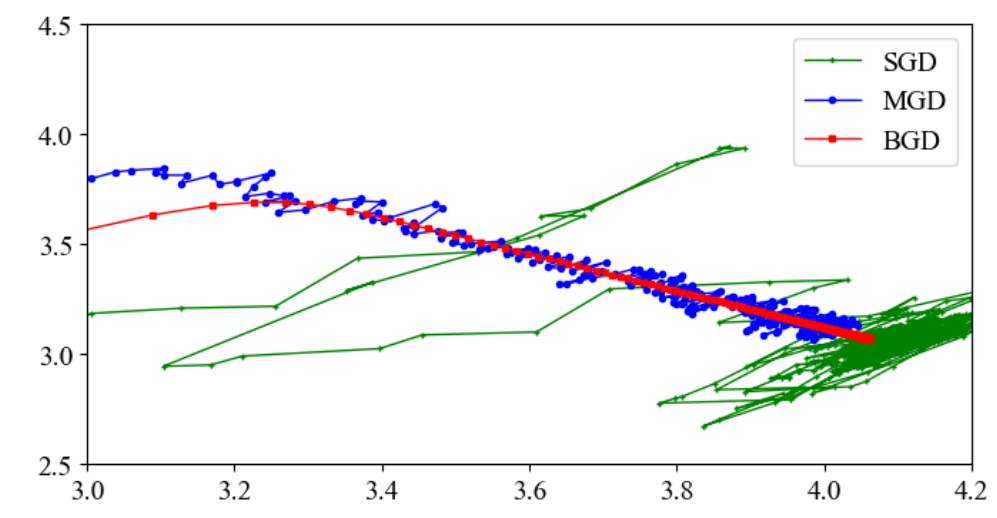
看红色的线,可以看到批量梯度下降像是直接往最终结果的方向走;再看蓝色的线,小批量随机梯度下降也是往最终结果方向前进,但是过程有一些波动;最后看绿色的线,随机梯度下降的前进方向波动更大。




 浙公网安备 33010602011771号
浙公网安备 33010602011771号